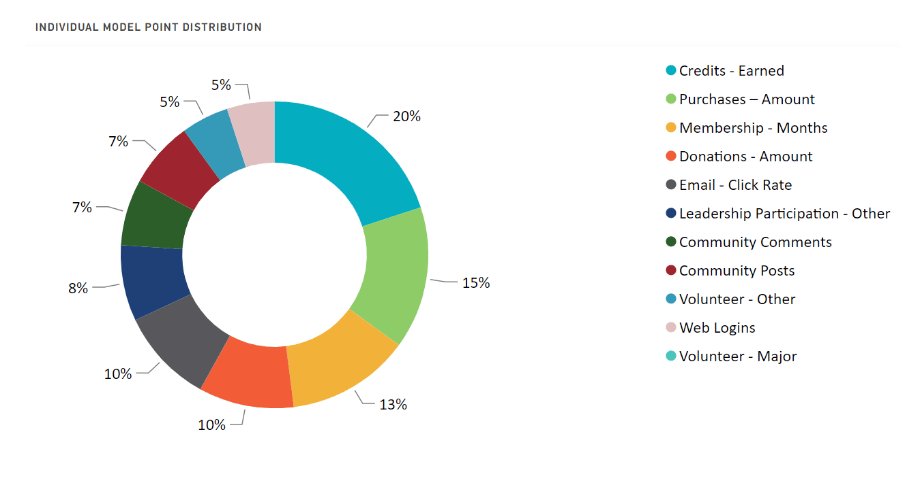Take the Guesswork out of Measuring Member Engagement with Engagement Scoring

Ask almost any association executive to name their organization’s top strategic priority, you’re likely to get the same answer today as you would have a decade or more ago: increase member engagement. While each association may define the activities and behaviors that make up member engagement a bit differently, the basic definition centers around the exchange of value. Members who value your association and its mission are are more likely to invest more time, money or intellectual bandwidth with the association doing things like volunteering, contributing content or expertise, participating in online community discussions, attending events and other things the association in turn receives value for.
But how do you tie these behaviors to business outcomes like revenue, retention, or member satisfaction? That’s where engagement scoring comes in. There is a common misconception that a member’s engagement score directly correlates to one metric, such as renewals. While it’s true that more engaged members have higher renewal rates, engagement scoring provides a way to dive deeper into engagement metrics and the ways various interactions impact key business outcomes beyond just renewals.
Not sure what engagement scoring means, or where to start? I’ve got you covered.
What is engagement scoring?
Engagement scoring is a method of assigning points to meaningful member interactions (activities), deciding how much each should count (weights) then using the results to compare highly engaged members against less engaged members to glean insights that inform business outcomes.
Now that you’ve got that down, maybe you’re ready to give it a try at your organization? Just follow the three-step guide below and you’ll be ready to lead your association’s first crack at engagement scoring.
Step 1: Choose activities
Start with a modeling workshop with staff who interact with members from across the organization (for example, membership, education, marketing, events, digital, and communications). I realize that any time you bring together stakeholders from across the association, you’re likely to come away with a long list of activities each insists is critical to measure. However, in this case, keeping the number of activities between about five and 10 will generate the most valuable results.
Encourage the team to consider activities that drive:
- Operational outcomes that directly impact revenue like renewals, purchases, meeting attendance, and course registration.
- Customer experience, like those that show you are providing a great member experience and improving your relationship with members (Examples: survey responses, community engagement).
- Strategic objectives, which can be harder to measure—consider things like content downloads, CE credits, traffic to resources that tie back to specific goals.
Step 2: Assign weights for a meaningful engagement score
Begin with an overall model of 100 as a perfect score. Since members who achieve all points are pretty rare, you’ll want to define the number that equates to a “good” score. Then assign a weight—maximum score—to each activity. For example, if you weight event attendance at 30, a person who attends all events would get 30 points while one who attends some events might only get 15.
Engagement points for each section are based on comparison to all members, so keep this in mind when defining activities. In order to come up with broadly applicable engagement scores, you’ll want include activities that are broadly applicable to all members, rather than things like board membership or recipient of special awards.
Here’s an example of the activities one association used, and the weights assigned to each. Notice that the total percentage is 100, with credits earned weighted at 20%, purchases at 15% and so on. Here’s a template [Excel download] you can use to kick start your association’s member engagement scoring journey.
Step 3: Calculate scores
Now you’re ready to calculate engagement scores. The weighting process determined how important each activity was relative to the others based on a total 100-point scale. To calculate scores, use data—don’t manually assign scores! In terms of the sources, types and amount of data to use, remember these important considerations that can make or break the value of your scoring efforts:
- A good range of data to start with is three years’ worth. Limiting to just the past year won’t yield enough information to provide optimal insights; pulling data from a 10-year period would not only dilute its validity and relevance but would also include a huge amount of outdated and/or incorrect useless information. A good period of time to start with is three years.
- Avoid including only data from your AMS. Building a 360-degree view of member engagement is critical if you want to maximize the power of engagement scoring to inform business outcomes. Limiting the data to transactional data housed in your AMS means that the resulting engagement scores would almost surely be of significantly lower business value than the intended engagement data this whole endeavor is meant to capture and harness in any meaningful way.
- Don’t forget sources of unstructured data, such as online communities, social channels and member feedback from things like survey responses.
My association is excited to start using engagement scores to enhance business outcomes! Where should we start?
There are so many ways your organization can begin to use the data generated through engagement scoring. I’ll end with just a few examples and hope to read additional tips and case studies from associations that have begun tapping the power of member engagement scoring.
Use individual engagement scores to find:
- Buyers
- Attendees
- Speakers
- Donors
- Award nominees
- Volunteers
- At-risk members
Bonus resources to kick-start your association’s engagement scoring efforts
- Here’s a template spreadsheet to help you get started with your engagement scoring
- This video clip that walks you through how to use the worksheet
- Check out our entire webinar on best practices for calculating your scores: Everything You Want to Know About Engagement Scoring (but didn’t know to ask)
Tags
Related Articles
Report Reveals Strategies to Overcome Membership Decline
McKinley Advisors’ Membership Reset report provides a roadmap that association leaders can use to refocus...
Member Retention: More Than Just a Number
Learn how the AANA used humor and multichannel marketing to win back lapsed members.
Building Tomorrow: HACIA’s Member Development Initiatives Are Reshaping the Construction Industry
Jacqueline Gomez, Executive Director of the Hispanic American Construction Industry Association (HACIA), describes the crucial...






